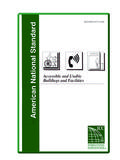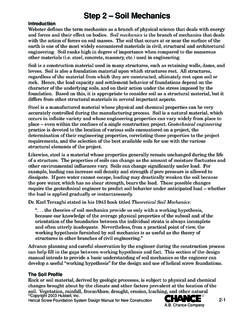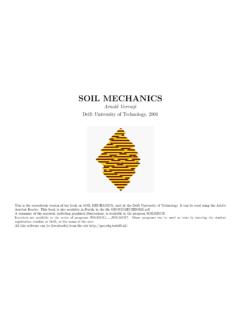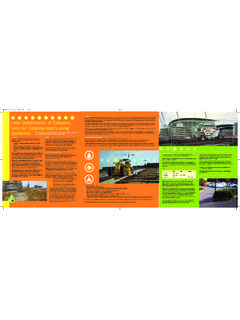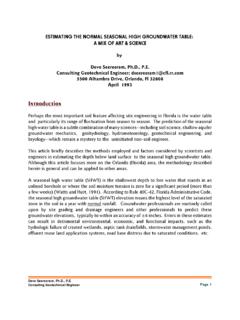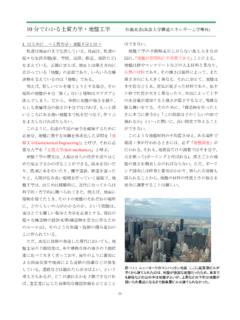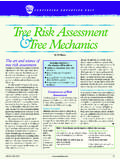Transcription of Appendix B The Unified Soil Classification System
1 Unified soil Classification System B-1 Appendix BThe Unified soil Classification SystemThe adoption of the principles of soil mechanics by the engineeringprofession has inspired numerous attempts to devise a simpleclassification System that will tell the engineer the properties of a givensoil. As a consequence, many classifications have come into existencebased on certain properties of soils such as texture, plasticity, strength,and other characteristics. A few Classification systems have gained fairlywide acceptance, but rarely has any System provided the completeinformation on a soil that the engineer needs.
2 Nearly every engineer whopractices soil mechanics will add judgment and personal experience asmodifiers to whatever soil Classification System he uses. Obviously, withina given agency (where designs and plans are reviewed by persons entirelyremoved from a project) a common basis of soil Classification is necessaryso that when an engineer classifies a soil as a certain type, thisclassification will convey the proper characteristics and behavior of thematerial. Further than this, the Classification should reflect thosebehavior characteristics of the soil that are pertinent to the project OF THE USCSThe USCS is based on identifying soils according to their textural andplasticity qualities and on their grouping with respect to behavior.
3 Soilsseldom exist in nature separately as sand, gravel, or any other singlecomponent. They are usually found as mixtures with varying proportions ofparticles of different sizes; each component part contributes its characteristicsto the soil mixture. The USCS is based on those characteristics of the soil thatindicate how it will behave as an engineering construction material. Thefollowing properties have been found most useful for this purpose and formthe basis of soil identification. They can be determined by simple tests and,with experience, can be estimated with some accuracy. Percentages of gravel, sand, and fines (fraction passing the No.)
4 200sieve). Shape of the grain-size-distribution curve. Plasticity and compressibility characteristics. In the USCS, the soil isgiven a descriptive name and a letter symbol indicating its AND SCOPEIt is the purpose of this Appendix to describe the various soil groups in detailand to discuss the methods of identification so that a uniform classificationprocedure may be followed by all who use the System . Placement of the soilsRETURN TO TOCB-2 Unified soil Classification SystemFM 5-472/NAVFAC MO 330/AFJMAN 32-1221(I)into their respective groups is accomplished by visual examination andlaboratory tests as a means of basic identification.
5 It is recognized that theUSCS in its present form may not prove entirely adequate in all , it is intended that the Classification of soils according to this systemhave some degree of elasticity and that the System not be followed blindly norregarded as completely rigid. DEFINITIONS OF soil COMPONENTSB efore soils can be classified properly in any System , including the onepresented in this manual, it is necessary to establish a basic terminology forthe various soil components and to define the terms used. In the USCS, theterms cobbles, gravel, sand, and fines (silt or clay) are used to designate thesize ranges of soil particles.
6 The gravel and sand ranges are furthersubdivided into the groups as presented in Ta b l e B - 1. The limitingboundaries between the various size ranges have been arbitrarily set atcertain US standard sieve sizes as listed in Tab le B -1. In the finest soilcomponent (below the No. 200 sieve), the terms silt and clay are usedrespectively to distinguish materials exhibiting lower plasticity from thosewith higher plasticity. The minus No. 200 sieve material is silt if the LL andPI plot below the A line on the plasticity chart and is clay if the LL and PIplot above the A line on the chart (all LL and PL tests are based on minusNo.)
7 40 sieve fraction of a soil ). The foregoing definition holds for inorganicsilts and clays and for organic silts but is not valid for organic clays sincethese latter soils plot below the A line. The names of the basic soilcomponents can be used as nouns or adjectives when describing orclassifying a Classification SYSTEMIn its simplest form, Figure B-1 illustrates the process of the classificationsystem. The following paragraphs provide detailed information on the soilproperties and groups as they pertain to the System . A short discussion of the USCS procedures (see Figure B-1, page B-3) ispresented so that the succeeding detailed description may be betterunderstood.
8 The procedures are designed to apply generally to theTable B-1. soil particle-size rangesComponentSize RangeCobblesAbove 3 inchesGravel Coarse Fine3 inches to No. 4 sieve 3 inches to 3/4 inch 3/4 inch to No. 4 sieveSand Coarse Medium FineNo. 4 to No. 200 sieves No. 4 to No. 10 sieves No. 10 to No. 40 sieves No. 40 to No. 200 sievesFines (clay or silt)Below No. 200 sieve (no minimum size) Unified soil Classification System B-3FM 5-472/NAVFAC MO 330/AFJMAN 32-1221(I)Figure B-1. USCS Unified soil Classification SystemFM 5-472/NAVFAC MO 330/AFJMAN 32-1221(I)identification of soils regardless of the intended engineering uses.
9 Table B-2,pages B-6 and B-7, also assists in identifying the symbols and soil descriptionswithin this System . Figure B-1 shows the schematic method of classifyingsoils from the results of laboratory tests. Columns 1 through 5 of Ta bl e B -2 ,pages B-6 and B-7 identify the three major divisions of the classificationsystem and the group symbols that distinguish the individual soil of typical and representative soil types found in each group are shownin column GROUPS AND GROUP SYMBOLSS oils are primarily identified as coarse grained, fine grained, and highlyorganic. On a textural basis, coarse-grained soils are those that have 50percent or more by weight of the overall soil sample retained on the No.
10 200sieve; fine-grained soils are those that have more than 50 percent by weightpassing the No. 200 sieve. Highly-organic soils are, in general, readilyidentified by visual examination. The coarse-grained soils are subdivided intogravel and gravelly soils (G) and sands and sandy soils (S). Fine-grained soilsare subdivided on the basis of their LL and plasticity properties; the symbol Lis used for soils with LLs of 50 and less and the symbol H for soils with LLs inexcess of 50. Peat and other highly organic soils are designated by the symbolPt and are not subdivided. In general practice there is no clear-cut boundary between gravelly soils andsandy soils and, as far as behavior is concerned, the exact point of division isrelatively unimportant.
